Canada is a large wilderness full of animals that can both help and harm you. Snakes are no exception, and over 20 species of snakes exist in The Great White North. In addition to the deadliest snakes in Canada, strong snakes slither in the southern part of the country, too.
Discover the eight strongest snakes in Canada to avoid.
What Constitutes Strength
Most of the time, in terms of “strength,” people think of venom strength for snakes. However, this article examines the physical strength of snakes in Canada. Most of the snakes on the list are powerful constrictors that can injure, maim, or kill their victims by constricting their bodies.
Snake constriction exerts force to kill or subdue prey. This offensive method enables snakes that do not have venom to hunt. Constriction often happens in the wild by a snake first striking its prey and biting down to bring the animal close. The snake will coil itself one or two times around the victim.
Popular belief often claims constrictors break the bones of their prey or suffocate them; however, neither is 100% true. While some individual anacondas have been known to break the bones of larger animals, that is never the constrictor’s main attempt. Instead, the snake pulls the anime in close to monitor its heartbeat and tightens its coil based on blood flow. A snake’s main aim is to halt blood flow to vital organs and induce unconsciousness in its victims.
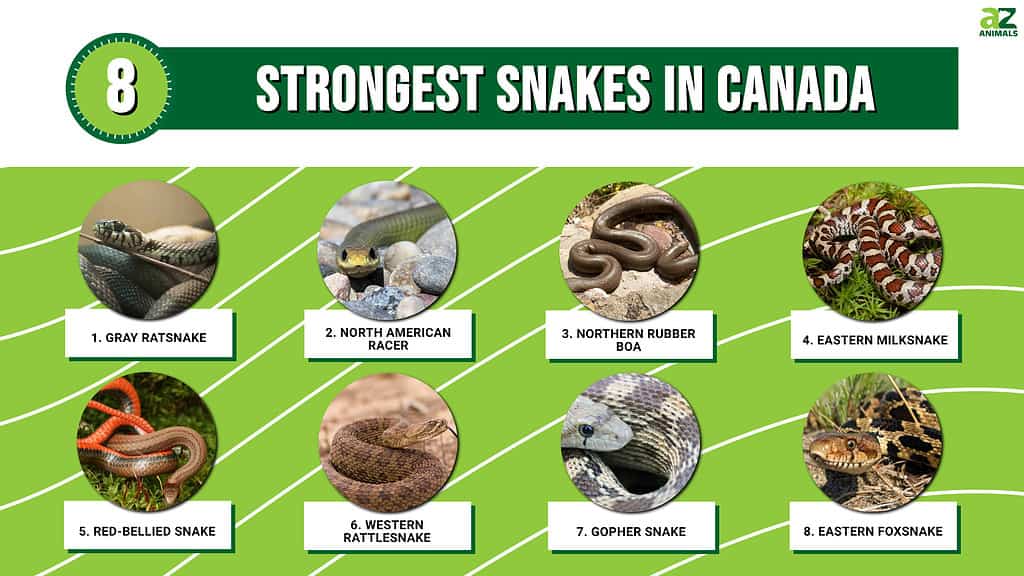
8 Strongest Snakes In Canada
1. Gray Ratsnake

Gray ratsnakes are non-venomous and live in trees.
©dkHDvideo/Shutterstock.com
Also commonly referred to as the central ratsnake or the chicken ratsnake, the gray ratsnake is a non-venomous snake. It uses constriction as a method for capturing and subduing its prey. Often, gray ratsnakes make their home in treetops.
The gray ratsnake lives up to its name with a pale gray body covered in scales. It also sports a light gray crown on its head. On the dorsal side of the snake, you’ll find dark blotches. For the most part, the color and markings of this snake follow it from juvenile life into adulthood.
Many regard the gray ratsnake as a skilled scent-hunter and powerful constrictor type of snake. While they will constrict larger prey to make them unconscious or kill them, gray ratsnakes tend to swallow their smaller prey alive.
The diet of a gray ratsnake changes as it matures. When it’s a neonate or juvenile snake, the gray ratsnake seeks out frogs and lizards. As a mature adult, it will feed on small mammals and birds via constriction. This snake will also eat bird eggs.
These snakes are mostly found in the southern parts of Ontario. To the southeast, these snakes make their homes in the Carolinian forest and along the north shore of Lake Erie. In the southwest, they’re found around the Great Lakes region.
2. North American Racer

A North American Racer will continually bite whatever is threatening it.
©Michael Chatt/Shutterstock.com
This non-venomous snake is endemic to North and Central America and begets 11 different subspecies. As they’re non-venomous, these snakes have additional defensive and offensive mechanisms, like wicked-fast movement speeds and wonderful vision. North American Racers attempt to flee from predators, but when cornered will put up an aggressive fight.
Depending on subspecies and environment, the North American racer looks a bit different. Usually, these snakes range between 20 to 60 inches in length and weigh just over a pound. Most subspecies have a lighter underbelly reflective of the color their name implies, like black, brown, blue, yellow, or green.
These racers stray away from the traditional method of constriction; instead of coiling around their prey, the snakes simply pin it with its full body and one or two coils on top. In addition, the North American racer has an aggressive, painful bite. It’s not a venomous bite, but the snake will continue biting its enemy until there’s an escape from the situation for it.
North American Racers fill their diets with a variety of small mammals, amphibians, and reptiles including rabbits, frogs, turtles, and other snakes. They don’t climb often, but when they do they’ll eat birds and bird eggs.
Location: Lucky for Canadians and their tourists, three types of subspecies exist in their country. The Western yellow-bellied racer, the blue racer, and the eastern yellow-bellied racer exist in many provinces in the country, including British Columbia, Alberta, Saskatchewan, and Ontario.
3. Northern Rubber Boa
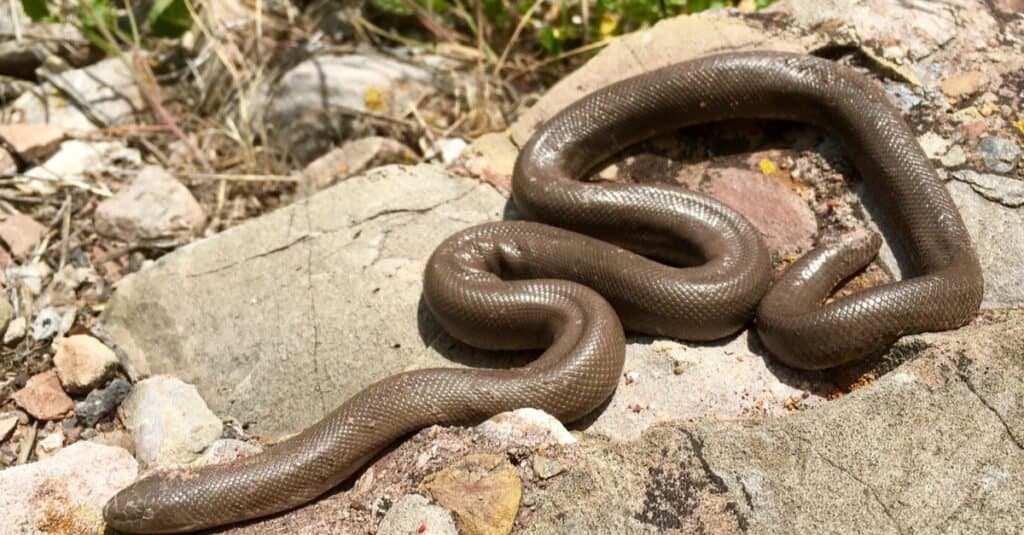
The northern rubber boa is a member of the boa constrictor family.
©Matt Jeppson/Shutterstock.com
Native to North America, the northern rubber boa is a non-venomous snake and a smaller member of the larger boa constrictor family. They are the most northern of any boa species on earth. Northern rubber boas are also known as simply “rubber boas” or “coastal rubber boas.”
While on the smaller side of their family, Northern Rubber Boas still range between 1.5 to 2.7 feet long. Their skin, which looks loose and wrinkly compared to their smooth and shiny scales, makes them aptly named. The colors of these snakes vary between pink, tan, and dark brown with orange or yellow surfaces.
Like other boa constrictors in their family, the northern rubber boa constricts its prey until death. These boas constrict all their prey rather than swallow them alive.
These boas hunt a variety of small mammals and vermin, like voles and rodents, but will eat salamanders, lizards, and young bats as well. When going after any nesting animal, the Northern Rubber Boa will attempt to eat the entire litter before the mother returns. If she does, the snake fends her off with its tail.
While only confirmed in British Columbia by The Canadian Encyclopedia, other sightings of the North American Boa have been reported in Alberta. Common regions for the Northern Rubber Boa in British Columbia include Pemberton, Williams Lake, and Radium Hot Springs.
4. Eastern Milksnake
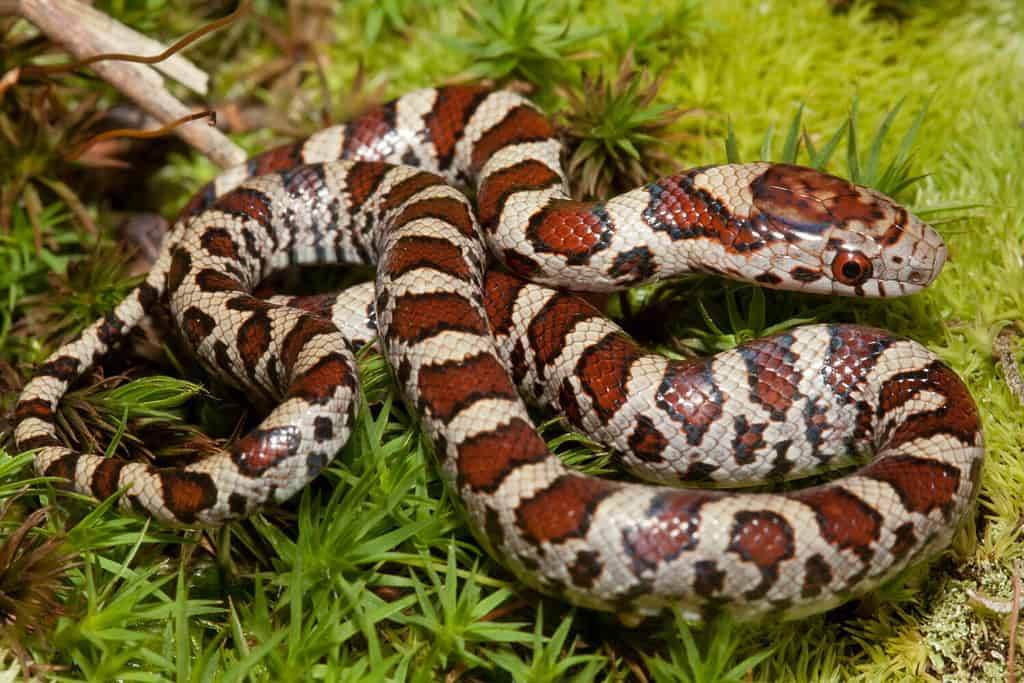
Eastern milksnakes look terrifying, but they are non-venomous.
©Nathan A Shepard/Shutterstock.com
Non-venomous and known by many different names, Eastern Milksnakes are also called:
- Adder
- Chain snake
- Checkered adder
- King snake
- Milk sucker
- Scarlet milk snake
- Thunder-and-lightning snake
It is indigenous to eastern and central North America — it’s even the official snake of Illinois.
On the smaller side of snakes, the Eastern Milksnake has a striking appearance with red splotches imposed on larger black splotches on a white background. Milksnakes grow to about three feet long on average but snakes as long as 52 inches have been recorded by scientists.
Did you know this snake uses its constriction aggressively to subdue and eat its prey? Because the milksnake is smaller and chooses fast prey to eat, it must quickly wrap its body around the animal and attempt to suffocate it.
Common food choices for the Eastern Milksnake include mice, slugs, other snakes, birds, and invertebrates. Like other snakes, their diets change as they mature. Neonates will choose to eat smaller snakes and insects and as they age, they’ll hunt more birds and rodents. These snakes also have venom-neutralizing properties in their blood, so they can eat venomous snakes they find without issues.
If you’re looking to find (or avoid) an eastern milksnake, they’re most often found in rural areas of Ontario and Quebec.
5. Red-Bellied Snake
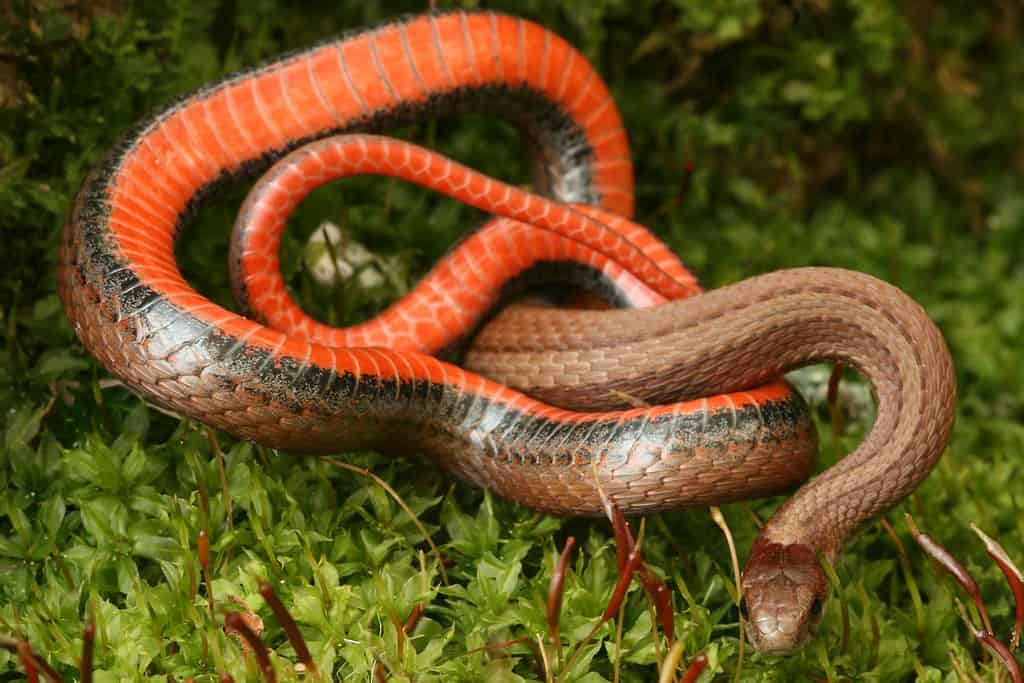
Red-bellied snakes are cousins to DeKay’s brownsnakes.
©Kevin Collison/Shutterstock.com
Some refer to this as a fire snake for its bright red or orange belly. No other nearby snake looks similar, making this a recognizable species.
As its name suggests, this snake has a bright red underbelly. In some cases, it may be orange or pink. The backs of these snakes can come in several different colors, including brown, red, and gray. Most have some sort of dark stripes along their backs and a ring around their heads. Red-bellied snakes remain on the smaller side, reaching a maximum length of only 15 inches.
These snakes often seek out invertebrates for the majority of their meals. Slugs, snails, grubs, and insects make up most of the red-bellied snake’s diet. While it is unlikely to bite or constrict you, this non-venomous snake can have a strong bite.
Red-bellied snakes can be found all over Canada in almost every province, including Saskatchewan, Manitoba, Ontario, Quebec, New Brunswick, Nova Scotia, and Prince Edward Island. These snakes frequent the edges of forests.
6. Western Rattlesnake
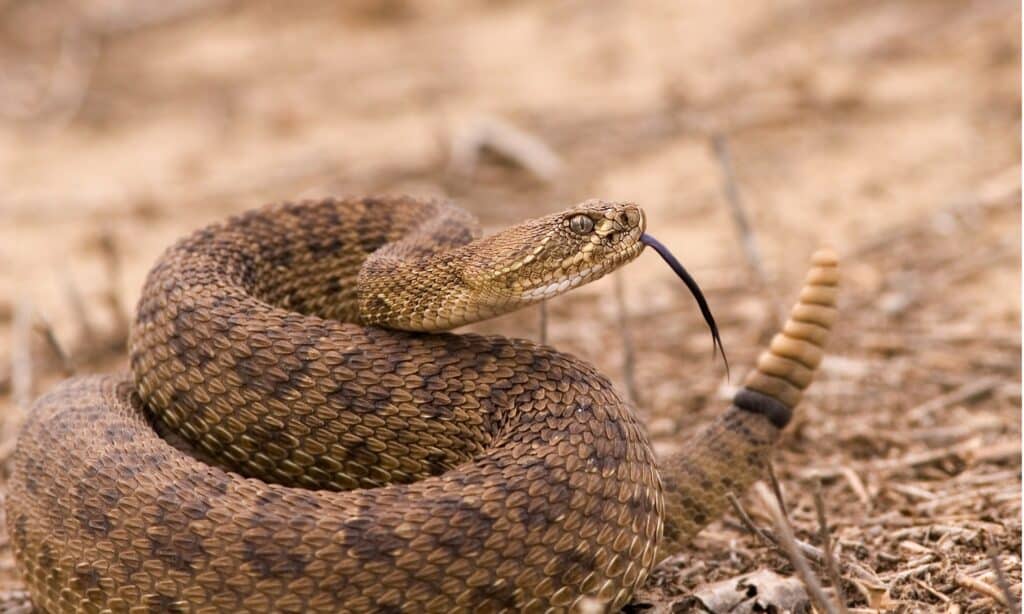
Western rattlesnakes are also called northern Pacific rattlesnakes.
©iStock.com/SteveMcsweeny
As the only venomous snake on the list, the western rattlesnake’s presence was included for its size and behavior. Western rattlesnakes are native to North America and one of three rattlesnakes in Canada. It is a pit viper, meaning it uses pits in its face to sense heat from prey.
These rattlesnakes look similar to other rattlesnakes and have semi-distinct patterns of dark-colored blotches with uneven white edges. Bellies on these snakes are usually pale yellow and may or may not have blotches. A western rattlesnake can grow up to 39 inches long.
Western rattlesnakes do not constrict to kill prey. Instead, they use their heat-sensing facial pits to find a meal. Western rattlesnakes often eat birds, rabbits, mice, and lizards. Unlike the diamondback rattlesnake in the United States, these snakes aren’t usually aggressive to humans. However, if you do accidentally corner or threaten one, be prepared for it to strike with a powerful and venomous bite.
Usually, you’ll only find western rattlesnakes in British Columbia.
7. Gopher Snake
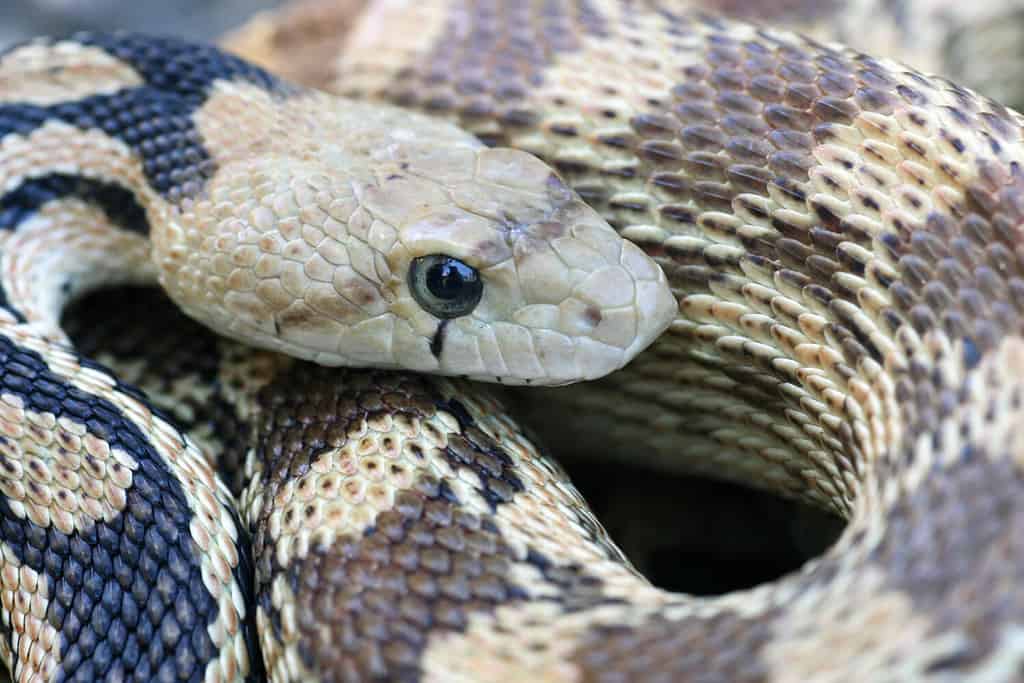
Close-up view of a Great Basin gophersnake, one of two subspecies found in Canada.
©Michael Benard/Shutterstock.com
The non-venomous gopher snake is often found in southwestern Canada. If you see a snake on the road, it’s most likely a gopher snake.
Gopher snakes are large, growing up to nearly five or six feet. They’re also heavy, making their bite force all the more terrifying — even though it lacks venom. Coloring will vary depending on subspecies and environment, but many gopher snakes have dark brown or black dorsal spots connected to each other in a line down the snake’s body.
While a gopher snake won’t constrict its prey, its bite is something to avoid. The bite is powerful, even without venom, and can cause severe pain.
Mostly consisting of mammals, the gopher snake’s diet includes — you guessed it — pocket gophers. However, these snakes will also settle for birds, lizards, and other small mammals.
Two subspecies of this snake exist in Canada: the Great Basin gophersnake and the bullsnake. Both make their homes in British Columbia, Alberta, and Saskatchewan in grassy areas. These snakes prefer grasslands, woodlands, deserts, agricultural land, and areas between rivers and streams.
8. Eastern Foxsnake
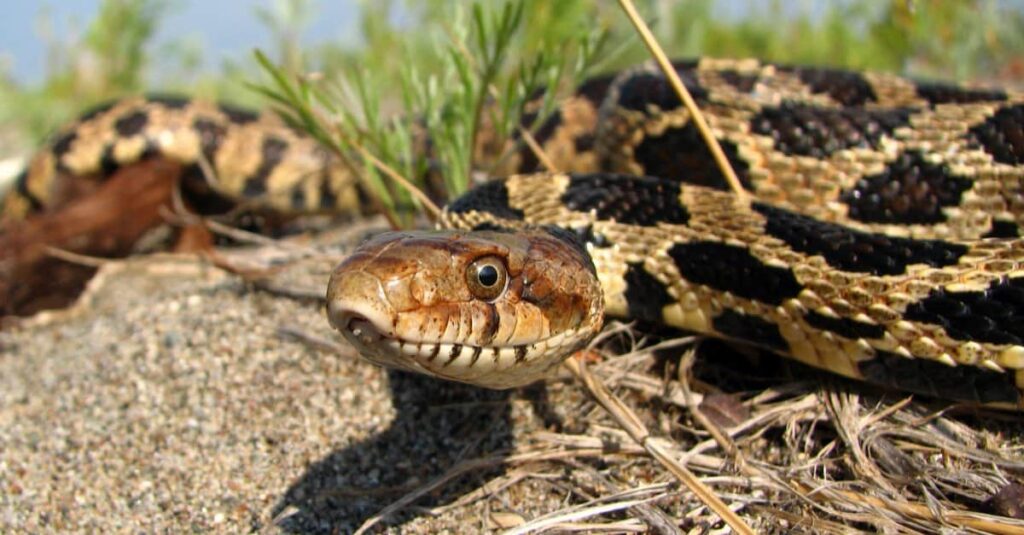
Eastern foxsnakes use their long, heavy body to constrict their meals.
©Ryan M. Bolton/Shutterstock.com
Also a ratsnake, the eastern foxsnake is a non-venomous snake endemic to the Great Lakes region in both America and Canada. Interestingly, its specific zoological nomenclature, Pantherophis vulpinus, means fox-like and references the snake’s musk, which smells similar to a fox.
Eastern foxsnakes have frightening appearances, with large red-brown or fully-brown blotches along their backs. The background of those blotches ranges between yellow, tan, and olive. The eastern foxsnake tends to grow between three and six feet. It is often mistaken for the copperhead snake.
The Eastern Foxsnake is a powerful constrictor that uses its strength to constrict and eat mammals, birds, and amphibians. In addition, it will mimic a rattlesnake by making a similar sound and wagging its tail as an intimidation tactic. If constriction and its mimicry don’t work, the Foxsnake will coil and strike.
Often found in marshes, wetlands, fields, and meadows, the Eastern Foxsnake is only found in Western Ontario. Across the Great Lakes, these snakes often enjoy Michigan and Ohio. Interestingly, these snakes are one of the most common intruders in homes.
Conclusion
Thankfully, Canada isn’t home to a plethora of overly-strong snakes. While several of these species have the ability to inflict significant injury, the majority are solitary animals who look forward to being left alone. Use caution when in the wilderness so as to not threaten or scare these snakes and you won’t have to feel the force of their bite or constriction.
Summary of the 8 Strongest Snakes in Canada
| Rank | Common Name | Scientific Name |
|---|---|---|
| 1 | Gray Ratsnake | Pantherophis spiloides |
| 2 | North American Racer | Coluber constrictor |
| 3 | Northern Rubber Boa | Charina bottae |
| 4 | Eastern Milksnake | Lampropeltis triangulum |
| 5 | Red-Bellied Snake | Storeria occipitomaculata |
| 6 | Western Rattlesnake (northern Pacific rattlesnake) | Crotalus oreganus |
| 7 | Gopher Snake | Pituophis catenifer |
| 8 | Eastern Foxsnake | Pantherophis vulpinus |
The photo featured at the top of this post is © Joe Farah/Shutterstock.com
Discover the "Monster" Snake 5X Bigger than an Anaconda
Every day A-Z Animals sends out some of the most incredible facts in the world from our free newsletter. Want to discover the 10 most beautiful snakes in the world, a "snake island" where you're never more than 3 feet from danger, or a "monster" snake 5X larger than an anaconda? Then sign up right now and you'll start receiving our daily newsletter absolutely free.
Thank you for reading! Have some feedback for us? Contact the AZ Animals editorial team.






